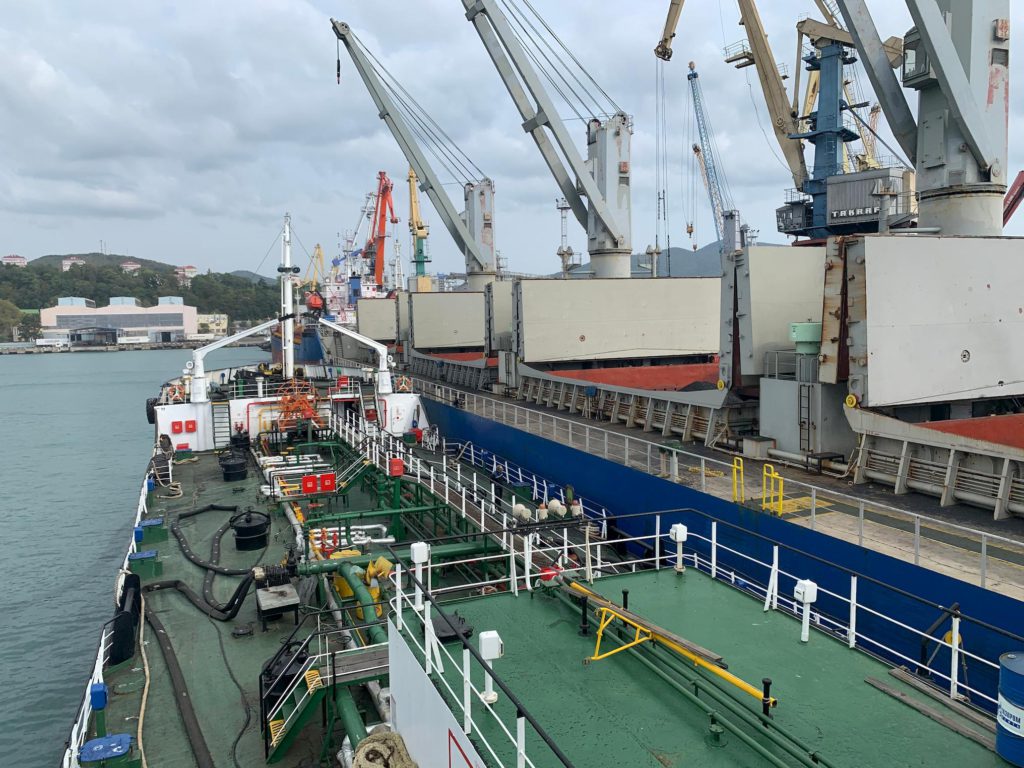
- BUNKERING OF THE VESSEL
7.1. Fuels and oils supplied to ships must be:
- comply with the quality of international and national regulations and regulations of the equipment manufacturers or the recommendations of the shipowner;
- have passports or certificates issued by authorized bodies, which indicate the brand and the main physical and chemical characteristics.
7.2. Unless otherwise provided by the requirements of the equipment manufacturers or the recommendations of the shipowner, the following physical and chemical characteristics must be specified in the passports or certificates:
7.2.1. For fuel:
- density at 20 °C,
- viscosity at 50/80 °C,
- flash point,
- solidification temperature,
- mechanical impurities,
- water content,
- sulfur content,
- ash content,
- coking ability.
7.2.2. For oils:
- kinematic viscosity at 40/100 °C,
- density at 15 °C,
- flash point,
- solidification temperature,
- base number or pH.
7.3. A sample must be taken from each batch of fuel and oil taken on board, which is stored on the ship for the entire period of use of each batch.
7.4. If there are signs that cause doubt as fuel or oil in their acceptance, possession or use of, the chief engineer shall send the selected sample to the lab specified or recommended by the shipowner for control analysis, the results of which the decision on the possibility of their use or claims provider.
7.5. Control over the acceptance, storage and consumption of fuels and oils on the ship and registration of the relevant documentation is carried out by the chief mechanic, who agrees with the captain of the ship on the procedure for filling the tanks and the flow from them. Signs and approves from the ship’s captain the technological map of fuel and oil intake on board the ship, gives an order to the watch mechanics on the order of fuel and oil consumption on board the ship.
7.6. Direct acceptance of fuels and oils on the ship is carried out by the mechanic in whose charge the specified systems are located, or at the direction of the chief mechanic — the watch mechanic. All operations for the reception of fuels and oils are carried out with the permission of the ship’s captain and with the knowledge of the officer of the watch.
7.7. The mechanic who carries out the acceptance of fuels and / or oils (the person responsible for the acceptance) must:
- draw up, sign and hand over to the chief mechanic a technological map indicating the sequence of opening and closing the valves, filling the tanks and the amount of oil product received by brand in each of them;
- to instruct the persons involved in bunkering;
- establish direct two-way communication with the bunkering ship or shore base;
- check the readiness of systems and containers for acceptance of petroleum products;
- act in accordance with the instructions for receiving fuel and oil, observe the technological map;
- take samples of each batch of accepted petroleum products;
- get a passport and/or a certificate for the accepted brands of fuel and oil from the bunkering operator, pass them to the chief mechanic;
- enter in the machine log the number of oil products accepted on the ship by brand.
7.8. The ship must have instructions for receiving fuel and oil, approved by the shipowner and reflecting:
- technological capabilities of the scheme and the recommendations of the filling of the vessel’s tanks;
- composition and control functions of the crew members during the acceptance of petroleum products;
- fire safety measures and prevention of marine pollution;
- sampling procedure.



 Write us WhatsApp
Write us WhatsApp


